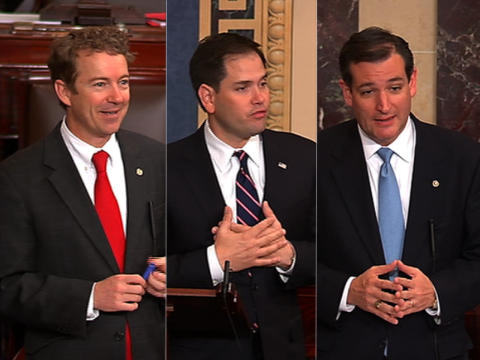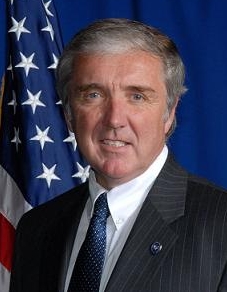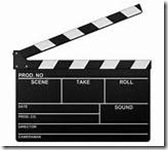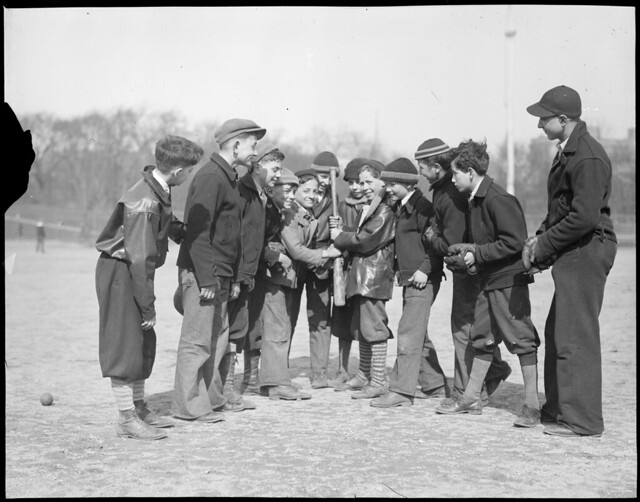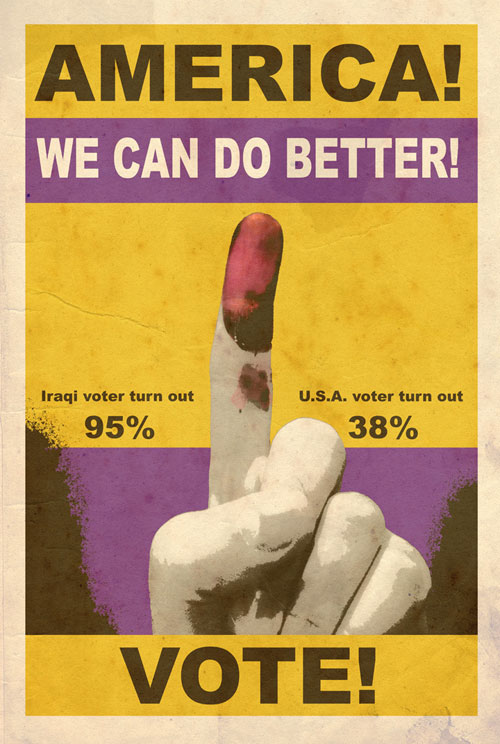

Former first lady Laura Bush, U.S. President Barack Obama and first lady Michelle Obama, former President George W. Bush, former President Bill Clinton and Former first lady Hillary Clinton, former President George H.W. Bush and former first lady Barbara Bush and former President Jimmy Carter attend the opening ceremony of the George W. Bush Presidential Center April 25, 2013 in Dallas, Texas. (Former living first ladies Rosalynn Carter and Nancy Reagan did not attend.)
WAPO: George W. Bush will return to the spotlight this week for the dedication of his presidential library, an event likely to trigger fresh public debate about his eight fateful years in office. But he reemerges with a better public image than when he left Washington more than four years ago.
Since then, Bush has absented himself from both policy disputes and political battles. A new Washington Post-ABC News poll suggests that the passage of time and Bush’s relative invisibility have been beneficial to a chief executive who left office surrounded by controversy.
Days before his second term ended in 2009, Bush’s approval rating among all adults was 33 percent positive and 66 percent negative. The new poll found 47 percent saying they approve and 50 percent saying they disapprove. Among registered voters, his approval rating today is equal to President Obama’s, at 47 percent, according to the latest Post-ABC surveys.
Majorities said they still disapprove of Bush’s performance on the Iraq war and the economy, but his economic approval numbers nearly doubled between December 2008 and today, from 24 percent to 43 percent, with 53 percent disapproving. Iraq remains the most troublesome part of his legacy. Today, 57 percent say they disapprove of his decision to invade, though that is down from 65 percent in the spring of 2008, the last time the question was asked.
Historians say it will take years, even decades, for any substantial revision of his presidency to take place. Bush has said he is content to let history judge him and told the designers of his presidential museum to present the facts and let visitors decide whether he was right. But some allies see Thursday’s official opening of the library in Dallas as an opportunity to begin to set his presidency into broader perspective.
“Obviously, it’s a big moment for him,” former British prime minister Tony Blair said in a telephone interview from London. “It’s a chance for him to explain that his political philosophy encompasses much more than the decisions he had to take after 9/11. We forget this sometimes. . . . This is a much more rounded person with many more dimensions to him than the caricature often portrays.”
Contemporary judgments of Bush’s presidency have been harsh. The war in Iraq, which he launched on the basis of faulty intelligence in the aftermath of the attacks of Sept. 11, 2001, left this country deeply divided. His final months in office brought a collapse of the financial system that led to the worst recession since the Great Depression. In between, his administration’s wobbly response to Hurricane Katrina damaged his image.
But Bush will return to public view at a moment when some parts of his record are being viewed more charitably. His advocacy for immigration reform and his relative success at attracting Hispanic votes, for example, are now seen as a model for a Republican Party that has awakened to its glaring deficit in the Latino community.
Thursday’s events are likely to be shorn of partisanship, though commentary around them may not be. The guest list will be topped by Obama and all living former presidents, including Bush’s father, George H.W. Bush. Blair, who stood steadfastly with Bush after the 2001 attacks and his decision to invade Iraq 18 months later, will be among the many dignitaries and Bush administration alumni who will gather on the campus of Southern Methodist University.
Karen Hughes, who served as counselor to Bush, said the former president told her that he considers the day “a joyful opportunity to give thanks” — to the other presidents for being there, to those who served in his administration, to the workers who built the architecturally handsome Bush Center.
Former advisers say no one should expect the opening of the library and museum to bring a notable change in Bush’s generally low-profile post-presidency. “It’s a little too simplistic to say this is some big coming out or that some definitive change will happen that will mark a new approach to things by Bush or his people,” said Karl Rove, who served as Bush’s chief political adviser and White House deputy chief of staff.
Still, members of Bush’s team recognize the significance of the moment and are prepared to take on some of his critics, if necessary, amid the glare of media attention this week. “Clearly some pretty significant distortions have been fostered by the current president and others,” Hughes said. “Those of us who worked for him see it [the dedication ceremony] as an opportunity to set the record straight in some cases.”
Bush advisers believe that over time, more attention will focus on aspects of his presidency that were overshadowed by the controversies of his national security and economic records. They point to his initiative to combat HIV/AIDS in Africa, which has helped save hundreds of thousands of lives; his efforts to bring accountability and higher standards to public education; and his advocacy for comprehensive immigration reform, which was rejected by his party.
Bush’s decision to stay out of the public arena in recent years reflects his humility and his belief that he owed his successor “a decent interval of silence,” as Rove called it. He played no role in the 2012 campaign, neither attending the Republican National Convention last summer nor campaigning for Mitt Romney last fall. But there was no clamor among the Republican candidates for his participation.
Instead, Bush has quietly pursued activities that grew out of his presidential agenda. Much of that work, focusing on global health, the role of women in the Middle East, education and the economy, is carried out through the Bush Institute, which was founded in 2009 and shares the 23-acre site at SMU with the presidential library and museum.
The institute and the new museum are designed to highlight the values and principles that guided Bush in office. “Freedom is really the one central axis around which everything revolves,” said Mark Langdale, president of the George W. Bush Foundation.
Bush and former first lady Laura Bush have spent time in Africa on projects related to the AIDS initiative and other health issues. The former president also spends considerable time with wounded veterans and has participated with them in vigorous mountain-biking expeditions. He has taken up painting. He and his wife recently became grandparents for the first time.
He gave 70 speeches last year and plans 60 or so this year, according to Dan Bartlett, who was counselor to Bush in the White House. The paid speeches are all off the record, but one adviser said Bush is extremely candid in the question-and-answer sessions. He and former president Bill Clinton have done a series of joint appearances.
Last week’s Boston Marathon bombing was a tragic reminder of the episode that changed Bush’s presidency. After 9/11, Bush implemented aggressive anti-
terrorism policies, many of which were embraced by the Obama administration, though not the controversial interrogation measures authorized under Bush. A recent report by the Constitution Project concluded that those policies resulted in torture of some detainees.
Some Bush allies say Obama has gone out of his way to be critical of his predecessor and often has not acknowledged what they contend were key policies that have been helpful to him. They highlight two decisions by the former president that have proved beneficial to Obama in office: One was the troop surge in Iraq, which was highly controversial at the time but which, they contend, made it possible for Obama to end the war as quickly as he did.
The other was Bush’s decision in the fall of 2008 to press Congress to pass the Troubled Assets Relief Program (TARP) to bail out financial institutions. That was equally controversial, especially among Bush’s fellow Republicans, but his advisers argue that it helped stabilize the financial system before Obama took office.
“Both reflected strong presidential leadership and, as we now see in retrospect, excellent judgment,” said Joshua Bolten, who served as Bush’s White House chief of staff.
Bolten also noted that spending during most years of Bush’s presidency was below 20 percent of gross domestic product, the target now established by House Republicans in their budget blueprint. No president since Richard M. Nixon, other than Clinton, can make such a claim, he said.
But on fiscal issues, Bush draws criticism from both left and right. Tea party Republicans regard him as a reckless spender. Democrats say his tax cuts and two wars that were not paid for helped create larger deficits, though Obama accepted making the bulk of those cuts permanent last December.
Maya MacGuineas, president of the Committee for a Responsible Federal Budget, said the country would be happy to have the deficit levels of Bush’s presidency, but she declined to praise his overall record. She said that his record on neither tax cuts nor spending “was particularly fiscally responsible.”
Bush has continued to bear much of the culpability for the condition of the economy. On Election Day last November, 53 percent of voters said they blamed Bush for the current economic problems, while 38 percent blamed Obama, according to exit polls.
Iraq looms larger than perhaps any other issue over Bush’s legacy, but Blair said the former president’s attitude toward his decisions has not changed. “There was never any doubt while he was in office, and there’s not any doubt now,” he said.
Blair said Bush continues to believe that the world is safer without Saddam Hussein in power and added: “When you see what is happening in Syria today, the sense of that argument is evident. . . . What it does is just make clear that these decisions are very difficult. If you intervene, it can be very tough. If you don’t intervene, it can also be very tough.”
One section of the Bush museum, known as the Decision Points Theater, focuses on four key decisions: the invasion of Iraq, the troop surge, the financial crisis and the response to Hurricane Katrina. Visitors will hear the information available to the president at the time and then choose what they would do in each case. Bush, on video, will explain his decisions.
Presidential historian Douglas Brinkley of Rice University recently toured the Bush museum; he called it “beautifully designed” but predicted that it would spark controversy. “It’s going to be mocked and trashed by liberal Democrats, and conservative Republicans are going to say what a marvelous place it is,” he said. As for Bush’s potential place in history, he said, “It’s going to be hard for him to rehabilitate fully.”
Stanford University’s David Kennedy predicted that judgments about Bush are not likely to change unless perceptions of Iraq and what triggered the financial crisis change first. Presidents are judged on foreign policy and economic policy, he said, adding: “In neither one of those areas do I see anything on the horizon that will change people’s opinion.”
But H.W. Brands, a professor of history at the University of Texas, said it’s quite possible that Bush’s legacy could undergo a genuine reworking as time passes. “The worse a president’s reputation when he leaves office, the better chance there is for revision,” he said. “Every so often there’s a new generation of historians, and they have to come along and challenge the conventional wisdom.”

Busts of presidential pets Barney and Miss Beazley are seen during a tour of the George W. Bush Presidential Center - which will house the George W Bush library.
Related:
Star-Studded Political A-List Gathers for Bush Library Unveiling
George W Bush library to open as former President's popularity soars
Busts of presidential pets Barney and Miss Beazley at George W. Bush Library
U.S. Presidential Libraries
Bush 43 Portraits Hung in White House
